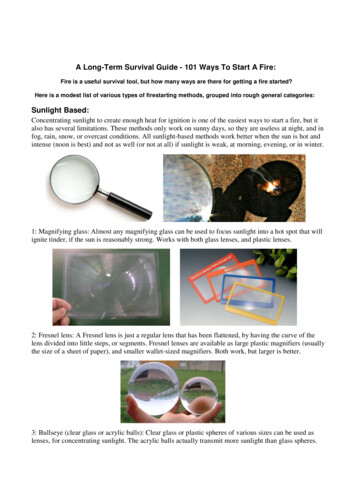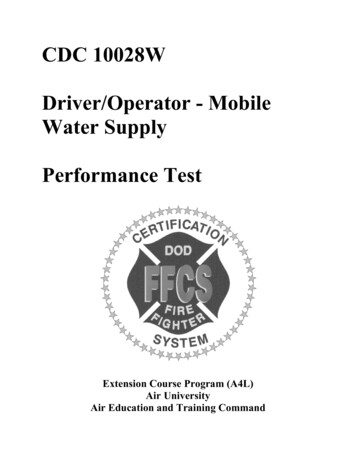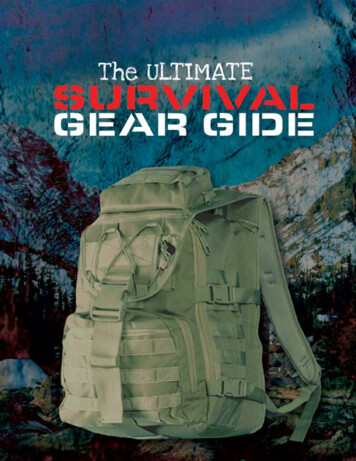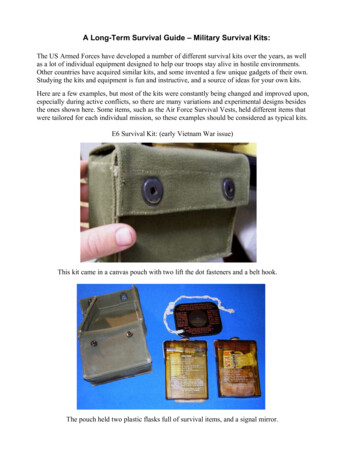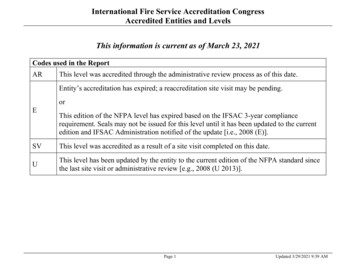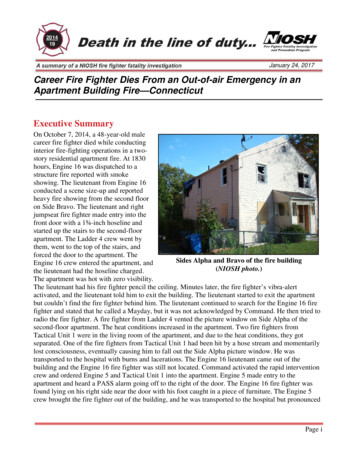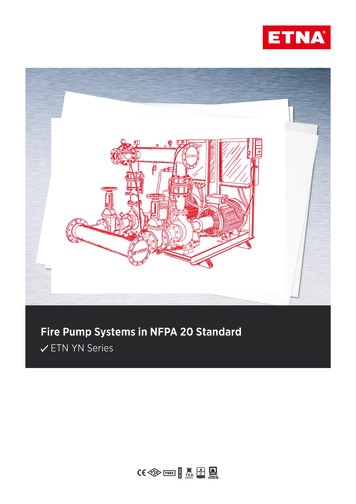
Transcription
FIRE FIGHTER SURVIVALApproved and Adopted by theOffice of the State Fire MarshalRecommended for adoption by theStatewide Training and EducationAdvisory Committee and theState Board of Fire ServicesPrimaryInstructorTrainee TaskBookOctober 2010CAL FIRE/OSFMState Fire
STATE FIREFIRE FIGHTER SURVIVALPrimary Instructor Trainee Task BookPrimary Instructor Trainee Task Book Qualifications Primary Instructor Trainee Evaluator Responsibilities Primary Instructor Trainee Evaluator Instructions for Completing the Task Book Instructor Trainee Evaluation Sheets Evaluator Summary SheetsOctober 2010STATE FIRE
STATE FIREFIRE FIGHTER SURVIVALSTATE FIREPrimary Instructor Trainee Task BookPrimary Instructor Trainee Task BookThe Fire Fighter Survival Primary Instructor Trainee Task Book lists every performance requirement(task) in a format that allows the trainee to be evaluated against written guidelines.Two different Fire Fighter Survival Primary Instructors (Evaluators) must be included in theevaluation process. It is essential that a trainee's performance be critically evaluated and accuratelyrecorded by each evaluator during the trainee's delivery at one or more Fire Fighter Survival classes.After the Primary Instructor Trainee has demonstrated competency in each area and the task book iscomplete, he or she may apply to become a registered Fire Fighter Survival Primary Instructor withState Fire Training once any remaining instructor requirements have been met.QUALIFICATIONSPrimary Instructor Trainee Successfully completed a SFT Fire Fighter Survival class. Attended and passed the Level 1 Instructor courses through SFT [one (1) of the following four (4)options]: Training Instructor 1A, 1B, and 1C. Fire Instructor 1A and 1B (available option through June 30, 2011). Fire Instructor 1A, Training Instructor 1A and 1C (available option through June 30, 2011). Fire Instructor 1B, Training Instructor 1B and 1C (available option through June 30, 2011). Rank and occupational experience. Held the rank of fire fighter and have a minimum of five (5) years suppression/rescueexperience within a California fire department.Evaluator Be a registered Fire Fighter Survival Primary Instructor in good standing with State Fire Training.RESPONSIBILITIESPrimary Instructor Trainee Review and understand all site requirements, equipment standards, and the material in the Fire Fighter Survival Manual.Review and understand the process for completing a Primary Instructor Trainee Task Book.Ensure the Primary Instructor Trainee Task Book is accurately recorded and maintained.Satisfactorily completed the task book within two (2) years of beginning the task book process.Satisfy all requirements and become registered within one (1) year of completing the task book.Retain a completed copy of his or her Primary Instructor Trainee Task Book in their personaland/or career records.October 2010 1
STATE FIREFIRE FIGHTER SURVIVALSTATE FIREPrimary Instructor Trainee Task BookEvaluator Be qualified and proficient. Explain to the Primary Instructor Trainee the purpose of and process for completing the task book. Explain to the Primary Instructor Trainee his or her responsibilities. Meet with the Primary Instructor Trainee and determine past experiences, current qualifications, and desired objectives/goals.Confirm with the Primary Instructor Trainee, prior to his or her performance, which tasks will beevaluated.Accurately evaluate each task being performed by the Primary Instructor Trainee.Document each task completed by the trainee on the Primary Instructor Trainee Task Book. Performance shall be documented by the evaluator directly on the task book. SFT's assigned class code. Date performance occurred. Evaluator's initials.Document your final evaluation of the Primary Instructor Trainee on the Evaluation Summarypage.INSTRUCTIONS FOR COMPLETING THE TASK BOOKThe Fire Fighter Survival Primary Instructor Trainee Task Book allows the Evaluator to record aPrimary Instructor Trainee's performance for delivering all aspects of a Fire Fighter Survival class.These evaluations are made by observing the Primary Instructor Trainee's administrative skills,presentation abilities, and manipulative performance techniques.Task Book HeadingsPrimary Instructor Trainee:Tasks:Grade:Date Observed:Evaluator's Initials:Enter the trainee's name.Lists every component required of a Primary Instructor in the FireFighter Survival Manual.Area to record the Primary Instructor Trainee's performance.The Evaluator enters the date the Primary Instructor Trainee wasassessed.The Evaluator enters his or her initials.October 2010 2
STATE FIREFIRE FIGHTER SURVIVALSTATE FIREPrimary Instructor Trainee Task BookPRIMARY INSTRUCTOR TRAINEE:PERFORMANCE STANDARD: All tasks must be demonstrated by the Primary Instructor Trainee and evaluated by a Fire FighterSurvival Primary Instructor. Tasks graded "P" must be functional and safe according to the Fire Fighter Survival manual.GRADE:"P" - Successfully met the performance standard."F" - Did not meet the performance standard.Evaluator #1Date Grade InitialsTASKSADMINISTRATION1.Describe all site requirements2.Describe and safely use all required equipment3.Coordinate all required documents with SFT4.Describe the student registration process for SFTSTAFF ASSIGNMENTS1.Make staff assignments based on the needs of the classQUALIFYING THE PROPS1.Perform site walk around2.Ensure proper setup of all stations3.Condition of the propsFIRE FIGHTER SURVIVAL COGNITIVE TRAININGTopic 1: Orientation and Administration1.Course objectives2.Student evaluations3.Safety/injury reporting4.Developed calendar of events for this classTopic 2: Developing a Survival Attitude5.Safety and survival, creating the culture6.Attitude7.Government involvement to reduce fire fighter injuries/fatalities8.Focusing our attitudes towards fire fighter survivalTopic 3: Preventing the Fire Fighter Emergency9.NIOSH Case Study: Arizona (F2001-13)10. Size-up11. Your situation12. Building construction13. TrainingTopic 4: The Fire Fighter Emergency14. Sacramento Fire Department Green Sheet: Burn Injuries15. The term "Mayday"16. The fire fighter emergencyTopic 5: SCBA Emergencies17. SCBA training18. Air consumption for survival19. Consumption rate testing20. SCBA emergenciesOctober 2010 3 Evaluator #2Date Grade Initials
STATE FIREFIRE FIGHTER SURVIVALSTATE FIREPrimary Instructor Trainee Task BookPRIMARY INSTRUCTOR TRAINEE:PERFORMANCE STANDARD: All tasks must be demonstrated by the Primary Instructor Trainee and evaluated by a Fire FighterSurvival Primary Instructor. Tasks graded "P" must be functional and safe according to the Fire Fighter Survival manual.GRADE:"P" - Successfully met the performance standard."F" - Did not meet the performance standard.Evaluator #1Date Grade InitialsTASKS21. Alternative means of obtaining additional air22. SCBA confidence courseTopic 6: Fire Fighter Survival Skills23. Student's eligibility to participate24. Safety briefing25. Medical briefing26. Personal protective equipment, tools, and equipment27. SCBA component28. Site preparation29. What's in your pockets?Glossary30. Describe the terms included in the glossaryNIOSH Alert – Truss System Failures31. Describe the content of the articleFALL PROTECTION1. Ensure all equipment meets NFPA 1983: Standard on Life SafetyRope and Equipment for Emergency Services (2006)2. Ensure anchors are capable of supporting at least 5,000 pounds perstudent attached or must be designed, installed, and used as part of acomplete fall arrest system that maintains a safety factor of at leasttwo (CCR, Title 8, Section 1670)3. Ensure properly setup of fall protection as described in the Fire FighterSurvival manual (Topic 6)ENTANGLEMENT PROP1.2.Ensure proper setup as described in the Fire Fighter Survival manualEnsure appropriate instructor access to student if assistance isrequiredCONFIDENCE COURSE1.2.Ensure proper setup as described in the Fire Fighter Survival manualEnsure appropriate instructor access to student if assistance isrequiredPROFILE PROP1.2.Ensure proper setup as described in the Fire Fighter Survival manualEnsure appropriate instructor access to student if assistance isrequiredWALL BREACH STATION1. Ensure appropriate wall breach area (prop or acquired structure)available to support all studentsOctober 2010 4 Evaluator #2Date Grade Initials
STATE FIREFIRE FIGHTER SURVIVALSTATE FIREPrimary Instructor Trainee Task BookPRIMARY INSTRUCTOR TRAINEE:PERFORMANCE STANDARD: All tasks must be demonstrated by the Primary Instructor Trainee and evaluated by a Fire FighterSurvival Primary Instructor. Tasks graded "P" must be functional and safe according to the Fire Fighter Survival manual.GRADE:"P" - Successfully met the performance standard."F" - Did not meet the performance standard.Evaluator #1Date Grade InitialsTASKSSKILL #1: SCBA Emergency Procedure Check1.Review Topic 5: SCBA Emergencies with the students2.Ensure each student has SCBADemonstrating the Exercise (Student or Adjunct Instructor)3.Determine if there is a need; is there a problem?4.Check for problems5.Check the bypass or purge valve6.Simultaneous check the main cylinder valve and ensure it is fully openCheck the air pressureCheck the low-pressure line from the mask to the second stageregulator/pressure reducer for escaping air9. Check that the high-pressure line is securely connected to cylinder10. Correct any problems when you find them during the emergencyprocedures check7.8.11. If you can't correct a problem, leave the area at once with assistanceConducting the Exercise12. Evaluate each student appropriately13. Critique the exercise with the students14. Discuss any key points that did not occur during the exerciseAfter the Exercise15. Critique the exercise with the Primary InstructorSKILL #2: Calling "Mayday"1.Confirm materials needed2.Prepare site (can be combined with another skill or evolution)3.Ensure students are wearing full PPE4.Secure tactical frequency for the exercise if availableDemonstrating the Exercise (Student or Adjunct Instructor)5.Locate the portable radio6.Press "Push To Talk"7.Call the "Mayday" The instructor will acknowledge the transmission8.Transmit your LUNAR9.State your personal procedures to assist in a successful recovery Activating the PASS device Monitoring and controlling your air Turning on your flashlight; making some noise Looking for exits (windows, doors, light from the outside) Staying calm; staying lowOctober 2010 5 Evaluator #2Date Grade Initials
STATE FIREFIRE FIGHTER SURVIVALSTATE FIREPrimary Instructor Trainee Task BookPRIMARY INSTRUCTOR TRAINEE:PERFORMANCE STANDARD: All tasks must be demonstrated by the Primary Instructor Trainee and evaluated by a Fire FighterSurvival Primary Instructor. Tasks graded "P" must be functional and safe according to the Fire Fighter Survival manual.GRADE:"P" - Successfully met the performance standard."F" - Did not meet the performance standard.Evaluator #1Date Grade InitialsTASKSConducting the Exercise10. Evaluate each student appropriately11. Rotate students so everyone completes the skill12. Critique the exercise with the students13. Discuss any key points that did not occur during the exerciseAfter the Exercise14. Critique the exercise with the Primary Instructor15. Release tactical frequency if utilizedSKILL #3: Reading Couplings1.Confirm materials needed2.Prepare site (can be combined with another skill or evolution)3.Assign personnel to appropriate positions4.Ensure students are wearing full PPEDemonstrating the Exercise (Student or Adjunct Instructor)5.Locate the hoseline6.Using your hands, search the hoseline until a coupling is located7.Find the male coupling Lugs on the male coupling are larger and run the entire lengthFollow the hoseline attached to the male coupling until you safely exitthe structureConducting the Exercise8.9.Evaluate each student appropriately10. Rotate students so everyone completes the skill11. Critique the exercise with the students12. Discuss any key points that did not occur during the exerciseAfter the Exercise13. Critique the exercise with the Primary InstructorSKILL #4: Window Hang1.Confirm materials needed2.3.Prepare siteConstruct an appropriate anchor in accordance with fall protectionsystem requirements4.Assign personnel/students to appropriate fall protection positions5.Review the fall protection system with all personnel/students6.7.Ensure each student is wearing full PPEEnsure each student is wearing a full-body harness attached to asafety line in accordance to the fall protection system requirements8.Perform a final safety check prior to demonstrating the skillOctober 2010 6 Evaluator #2Date Grade Initials
STATE FIREFIRE FIGHTER SURVIVALSTATE FIREPrimary Instructor Trainee Task BookPRIMARY INSTRUCTOR TRAINEE:PERFORMANCE STANDARD: All tasks must be demonstrated by the Primary Instructor Trainee and evaluated by a Fire FighterSurvival Primary Instructor. Tasks graded "P" must be functional and safe according to the Fire Fighter Survival manual.GRADE:"P" - Successfully met the performance standard."F" - Did not meet the performance standard.Evaluator #1Date Grade InitialsTASKSDemonstrating the Exercise (Student or Adjunct Instructor)9.Locate the window Closing the door to the room to buy additional time if possible10. Travel to the window Staying low due to heat and smoke11. Clear the window frame of glass and screen if needed Starting at the top to remove fire gasses and heat Removing any glass on landing on the sill to avoid any injury12. While on hands and knees, position yourself with one shoulderagainst the wall below the window13. Rise only enough to exit window Leading with your arm Then your head Then your leg Rolling over the sill Leaving other arm and leg inside on the sill for support14. Remain in this position until the fire is extinguished, a ladder is raised,or other rescue efforts can reach youConducting the Exercise15. Evaluate each student appropriately16. Rotate students so everyone completes the skill17. Critique the exercise with the students18. Discuss any key points that did not occur during the exerciseAfter the Exercise19. Critique the exercise with the Primary InstructorSKILL #5: Hose Slide1.Confirm materials needed2.4.Prepare siteConstruct an appropriate anchor in accordance with fall protectionsystem requirementsAssign personnel/students to appropriate fall protection positions5.Review the fall protection system with all personnel/students6.Ensure each student is wearing full PPEEnsure each student is wearing a full-body harness attached to asafety line in accordance to the fall protection system requirementsPerform a final safety check prior to demonstrating the skill3.7.8.October 2010 7 Evaluator #2Date Grade Initials
STATE FIREFIRE FIGHTER SURVIVALSTATE FIREPrimary Instructor Trainee Task BookPRIMARY INSTRUCTOR TRAINEE:PERFORMANCE STANDARD: All tasks must be demonstrated by the Primary Instructor Trainee and evaluated by a Fire FighterSurvival Primary Instructor. Tasks graded "P" must be functional and safe according to the Fire Fighter Survival manual.GRADE:"P" - Successfully met the performance standard."F" - Did not meet the performance standard.Evaluator #1Date Grade InitialsTASKSDemonstrating the Exercise (Student or Adjunct Instructor)9.Locate the window Closing the door to the room to buy additional time if possible10. Travel to the window Staying low due to heat and smoke11. Clear the window frame of glass and screen if needed Starting at the top to remove fire gasses and heat Removing any glass on landing on the sill to avoid any injury12. Push the nozzle and hoseline out the window Removing all slack13. Once the hoseline is out the window, proceed onto the window sill Staying low Placing one arm and one leg out the window Rotating body so both arms are in the room and both legs areoutside the window Balancing on your abdominal area14. Position yourself on the hoseline Grabbing hoseline above the sill with one hand and below the sillwith the other hand Wrapping legs around the hoseline Securing the hoseline between your knees and feet15. Travel down hoseline to a safe location Always maintaining four points of contact Feet, knees, both handsConducting the Exercise16. Evaluate each student appropriately17. Rotate students so everyone completes the skill18. Critique the exercise with the students19. Discuss any key points that did not occur during the exerciseAfter the Exercise20. Critique the exercise with the Primary InstructorSKILL #6: Ladder Escape – Hook-two/Slide-to-four Method1.Confirm materials needed2.3.Prepare siteConstruct an appropriate anchor in accordance with fall protectionsystem requirements4.Consider adding and securing a parallel ladder for an instructor5.Assign personnel/students to appropriate fall protection positionsOctober 2010 8 Evaluator #2Date Grade Initials
STATE FIREFIRE FIGHTER SURVIVALSTATE FIREPrimary Instructor Trainee Task BookPRIMARY INSTRUCTOR TRAINEE:PERFORMANCE STANDARD: All tasks must be demonstrated by the Primary Instructor Trainee and evaluated by a Fire FighterSurvival Primary Instructor. Tasks graded "P" must be functional and safe according to the Fire Fighter Survival manual.GRADE:"P" - Successfully met the performance standard."F" - Did not meet the performance standard.Evaluator #1Date Grade InitialsTASKS6.Review the fall protection system with all personnel/students7.8.Ensure each student is wearing full PPEEnsure each student is wearing a full-body harness attached to asafety line in accordance to the fall protection system requirements9.Perform a final safety check prior to demonstrating the skillDemonstrating the Exercise (Student or Adjunct Instructor)10. Locate the window Closing the door to the room to buy additional time if possible11. Travel to the window Staying low due to heat and smoke12. Clear the window frame of glass and screen if needed Starting at the top to remove fire gasses and heat Removing any glass on landing on the sill to avoid any injury13. Locate the ladder Leaning over the window sill Staying as low as possible Feeling for the ladder14. Place both hands on the beams15. Slide one hand along the beam to the fourth rung, while hooking theother hand under the second rung16. Grasp the fourth rung17. Prepare to transition your weight from the second rung down to thefourth rung18. Secure the second rung with the inside left elbow as a pivot point19. Rotate the body clockwise20. Slide right thigh down the right beam while rotating on left arm Keeping your head down and knees bent21. When rotation is complete, slide lower legs to the outer beams22. Slide down the ladder to the ground23. When you reach the bottom of the ladder, get out of the wayConducting the Exercise24. Evaluate each student appropriately25. Rotate students so everyone completes the skill26. Critique the exercise with the students27. Discuss any key points that did not occur during the exerciseAfter the Exercise28. Critique the exercise with the Primary InstructorOctober 2010 9 Evaluator #2Date Grade Initials
STATE FIREFIRE FIGHTER SURVIVALSTATE FIREPrimary Instructor Trainee Task BookPRIMARY INSTRUCTOR TRAINEE:PERFORMANCE STANDARD: All tasks must be demonstrated by the Primary Instructor Trainee and evaluated by a Fire FighterSurvival Primary Instructor. Tasks graded "P" must be functional and safe according to the Fire Fighter Survival manual.GRADE:"P" - Successfully met the performance standard."F" - Did not meet the performance standard.Evaluator #1Date Grade InitialsTASKSSKILL #7: Entanglement Emergencies – Swim or Sweep Method1.Confirm materials needed2.Prepare site3.Use appropriate entanglement props4.Ensure each student is wearing full PPE5.Perform a final safety check prior to demonstrating the skillDemonstrating the Exercise (Student or Adjunct Instructor)6.Identify the entanglement7.Identify your desired route Sweeping with outstretched arms to identify the largest possible8.opening that can be createdSwim or sweep through the opening Arms and head first Maintaining the opening the entire way through Avoiding the temptation to raise onto your elbowsRotate shoulders, SCBA, and waist through the largest portion of theopening10. Free yourself if a snag occurs9. Recognizing the resistance Stopping forward progress to release the tension Reaching for the entanglement Adjusting to work the snag free from your equipment Continuing through the entanglementConducting the Exercise11. Evaluate each student appropriately12. Rotate students so everyone completes the skill13. Critique the exercise with the students14. Discuss any key points that did not occur during the exerciseAfter the Exercise15. Critique the exercise with the Primary InstructorSKILL #8: Entanglement Emergencies – SCBA Removal Method1.Confirm materials needed2.Prepare site3.Use appropriate entanglement props4.Assign personnel to appropriate positions5.Ensure each student is wearing full PPE6.Perform a final safety check prior to demonstrating the skillOctober 2010 10 Evaluator #2Date Grade Initials
STATE FIREFIRE FIGHTER SURVIVALSTATE FIREPrimary Instructor Trainee Task BookPRIMARY INSTRUCTOR TRAINEE:PERFORMANCE STANDARD: All tasks must be demonstrated by the Primary Instructor Trainee and evaluated by a Fire FighterSurvival Primary Instructor. Tasks graded "P" must be functional and safe according to the Fire Fighter Survival manual.GRADE:"P" - Successfully met the performance standard."F" - Did not meet the performance standard.Evaluator #1Date Grade InitialsTASKSDemonstrating the Exercise (Student or Adjunct Instructor)7.Identify the entanglement8.Loosen harness straps9.Fully extend all straps10. Detach waist strap11. Remove the shoulder strap opposite of the air supply hose12. Remove the shoulder strap that contains the air supply hose Maintaining control of the air supply Without dislodging the SCBA mask13. Turn into the air pack and identify entanglement Turning into the air pack as opposed to moving the air pack aroundto the user reduces further entanglement14. Feel or sweep over the air pack15. Remove entanglements away from the harness, cylinder, valves Moving to a location that will prevent further entanglement when thepack is redonned16. Redon the air pack17. Adjust and gather equipment18. Continue toward the exit or safe areaConducting the Exercise19. Evaluate each student appropriately20. Rotate students so everyone completes the skill21. Critique the exercise with the students22. Discuss any key points that did not occur during the exerciseAfter the Exercise23. Critique the exercise with the Primary InstructorSKILL #9: Wall Breach1.Confirm materials needed2.Prepare site3.Use appropriate props4.Assign personnel to appropriate positions5.Ensure each student is wearing full PPE6.Perform a final safety check prior to demonstrating the skillDemonstrating the Exercise (Student or Adjunct Instructor)7.Locate the area to breach Closing the door to the room to buy additional time, if possible8.Identify the material to be breached9.Send a tool through the material firstOctober 2010 11 Evaluator #2Date Grade Initials
STATE FIREFIRE FIGHTER SURVIVALSTATE FIREPrimary Instructor Trainee Task BookPRIMARY INSTRUCTOR TRAINEE:PERFORMANCE STANDARD: All tasks must be demonstrated by the Primary Instructor Trainee and evaluated by a Fire FighterSurvival Primary Instructor. Tasks graded "P" must be functional and safe according to the Fire Fighter Survival manual.GRADE:"P" - Successfully met the performance standard."F" - Did not meet the performance standard.Evaluator #1Date Grade InitialsTASKS Ensuring there are no obstacles Checking the area to be entered is safe10. Make the breach Ensuring the opening is large enough to exit through quickly11. Exit the area Using a reduced profile if necessaryConducting the Exercise12. Evaluate each student appropriately13. Rotate students so everyone completes the skill14. Critique the exercise with the students15. Discuss any key points that did not occur during the exerciseAfter the Exercise16. Critique the exercise with the Primary InstructorSKILL #10: Changing Your SCBA Profile (Nonremoval)1.Confirm materials needed2.Prepare site3.Use appropriate profile props4.Assign personnel to appropriate positions5.Ensure each student is wearing full PPE6.Perform a final safety check prior to demonstrating the skillDemonstrating the Exercise (Student or Adjunct Instructor)7.Identify the opening to be used for escape Determining the size and shape Noting the largest portion as the most desirable for the SCBA8.Lie prone Stomach flat on the ground Head toward the opening9.Stretch your arms toward your head Loosening your shoulder straps if necessary, but not removing Attempting to touch your ears with your upper arms10. Manipulate yourself into and through the opening Arms and head into and through the opening first Rotating your shoulders, SCBA, and waist as necessary Avoiding the temptation to raise onto your elbows11. When you are through the opening, get out of the way12. Adjust and gather your equipment13. Move onOctober 2010 12 Evaluator #2Date Grade Initials
STATE FIREFIRE FIGHTER SURVIVALSTATE FIREPrimary Instructor Trainee Task BookPRIMARY INSTRUCTOR TRAINEE:PERFORMANCE STANDARD: All tasks must be demonstrated by the Primary Instructor Trainee and evaluated by a Fire FighterSurvival Primary Instructor. Tasks graded "P" must be functional and safe according to the Fire Fighter Survival manual.GRADE:"P" - Successfully met the performance standard."F" - Did not meet the performance standard.Evaluator #1Date Grade InitialsTASKSConducting the Exercise14. Evaluate each student appropriately15. Rotate students so everyone completes the skill16. Critique the exercise with the students17. Discuss any key points that did not occur during the exerciseAfter the Exercise18. Critique the exercise with the Primary InstructorSKILL #11: Change To Low/Reduced SCBA Profile (Partial Removal)1.Confirm materials needed2.Prepare site3.Use appropriate profile props4.Assign personnel to appropriate positions5.Ensure each student is wearing full PPE6.Perform a final safety check prior to demonstrating the skillDemonstrating the Exercise (Student or Adjunct Instructor)7.Identify the opening to be used for escape Determining the size and shape Noting the largest portion as the most desirable for the SCBA8.Loosen your waist strap, but do not remove9.Loosen both shoulder straps10. Remove the shoulder strap opposite the air supply hose Maintaining control of the shoulder strap Without dislodging the SCBA face piece11. Sling the SCBA under your arm Sliding it under the arm that the air supply hose travels over Positioning the top of the SCBA in your armpit Allowing the SCBA to rest along the side of your body Reaching down to hold the SCBA at the bottom or stem12. Outstretch your arm13. Lie flat on your side Attempting to touch your upper arm to your ear Avoiding temptation to rest on your elbow14. Manipulate into and through the opening Outstretched arm, head, and upper body first Rotating your shoulders through the largest opening Keeping your hand on the SCBA bottom or stem15. When you are through the opening, get out of the wayOctober 2010 13 Evaluator #2Date Grade Initials
STATE FIREFIRE FIGHTER SURVIVALSTATE FIREPrimary Instructor Trainee Task BookPRIMARY INSTRUCTOR TRAINEE:PERFORMANCE STANDARD: All tasks must be demonstrated by the Primary Instructor Trainee and evaluated by a Fire FighterSurvival Primary Instructor. Tasks graded "P" must be functional and safe according to the Fire Fighter Survival manual.GRADE:"P" - Successfully met the performance standard."F" - Did not meet the performance standard.Evaluator #1Date Grade InitialsTASKS16. Redon the air pack17. Adjust and gather your equipment18. Move onConducting the Exercise19. Evaluate each student appropriately20. Rotate students so everyone completes the skill21. Critique the exercise with the students22. Discuss any key points that did not occur during the exerciseAfter the Exercise23. Critique the exercise with the Primary InstructorSKILL #12: Changing To a Zero or No SCBA Profile (Full Removal)1.Confirm materials needed2.Prepare site3.Use appropriate profile props4.Assign personnel to appropriate positions5.Ensure each student is wearing full PPE6.Perform a final safety check prior to demonstrating the skillDemonstrating the Exercise (Student or Adjunct Instructor)7.Identify the opening to be used for escape Determining the size and shape Largest portion of opening as the most desirable for the SCBA8.Loosen and remove the waist strap9.Loosen both shoulder straps10. Remove both shoulder straps Strap opposite the air supply hose first Maintaining control of the shoulder straps Without dislodging your face piece11. Remove SCBA Maintaining constant contact with the pack Allowing the SCBA to be just ahead of your body Without dislodging your face piece12. Move into and through the opening Lying flat Starting with outstretched arm, head, and upper body Manipulating the shoulders through the opening Maintaining constant contact with the SCBA13. When you are through the opening, get out of the wayOctober 2010 14 Evaluator #2Date Grade Initials
STATE FIREFIRE FIGHTER SURVIVALSTATE FIREPrimary Instructor Trainee Task BookPRIMARY INSTRUCTOR TRAINEE:PERFORMANCE STANDARD: All tasks must be demonstrated by the Primary Instructor Trainee and evaluated by a Fire FighterSurvival Primary Instructor. Tasks graded "P" must be functional and safe according to the Fire Fighter Survival manual.GRADE:"P" - Successfully met the performance standard."F" - Did not meet the performance standard.Evaluator #1Date Grade InitialsTASKS14. Redon the SCBA15. Adjust and gather your equipment16. Move onConducting t
Fighter Survival Manual. Review and understand the process for completing a Primary Instructor Trainee Task Book. Ensure the Primary Instructor Trainee Task Book is accurately recorded and maintained. Satisfactorily completed
